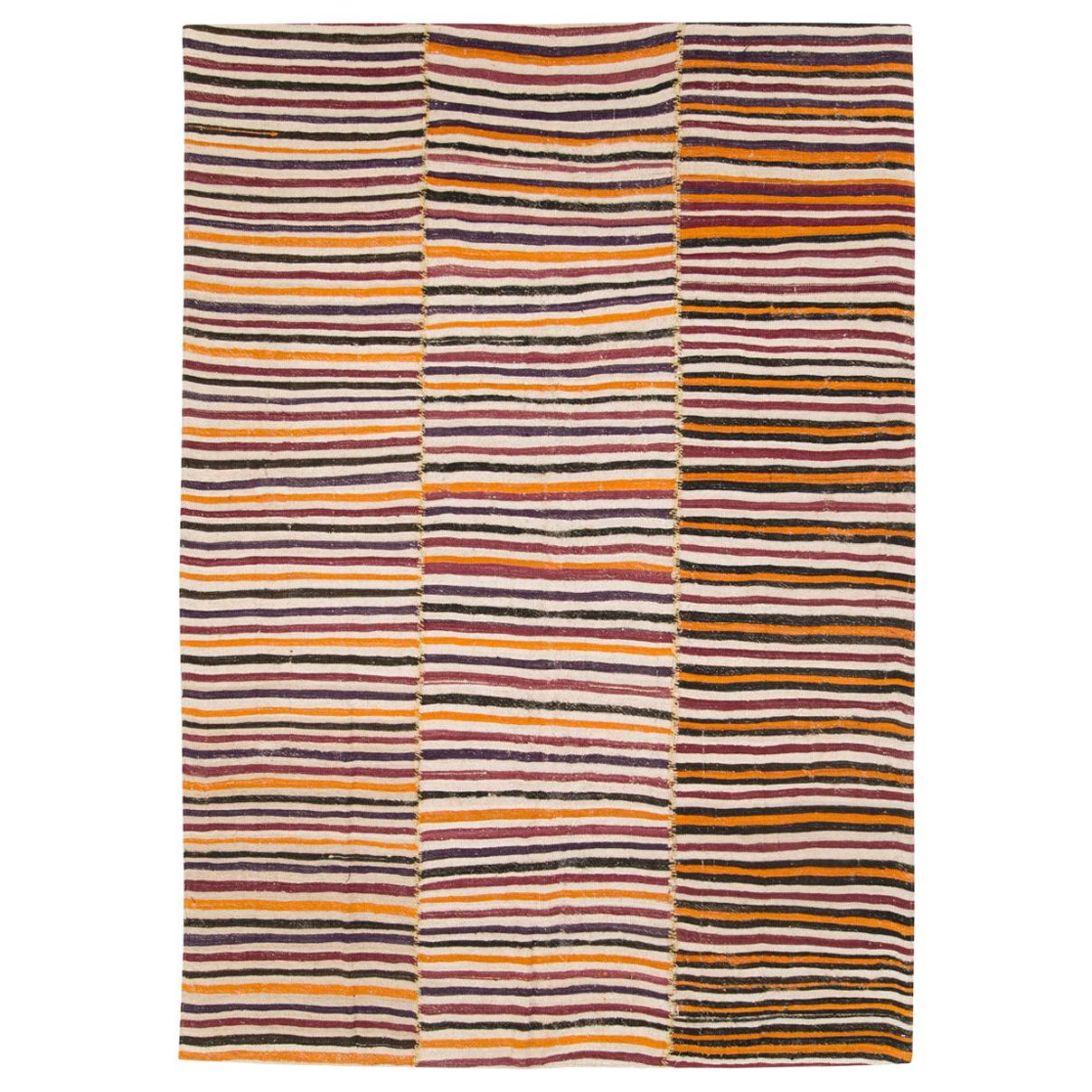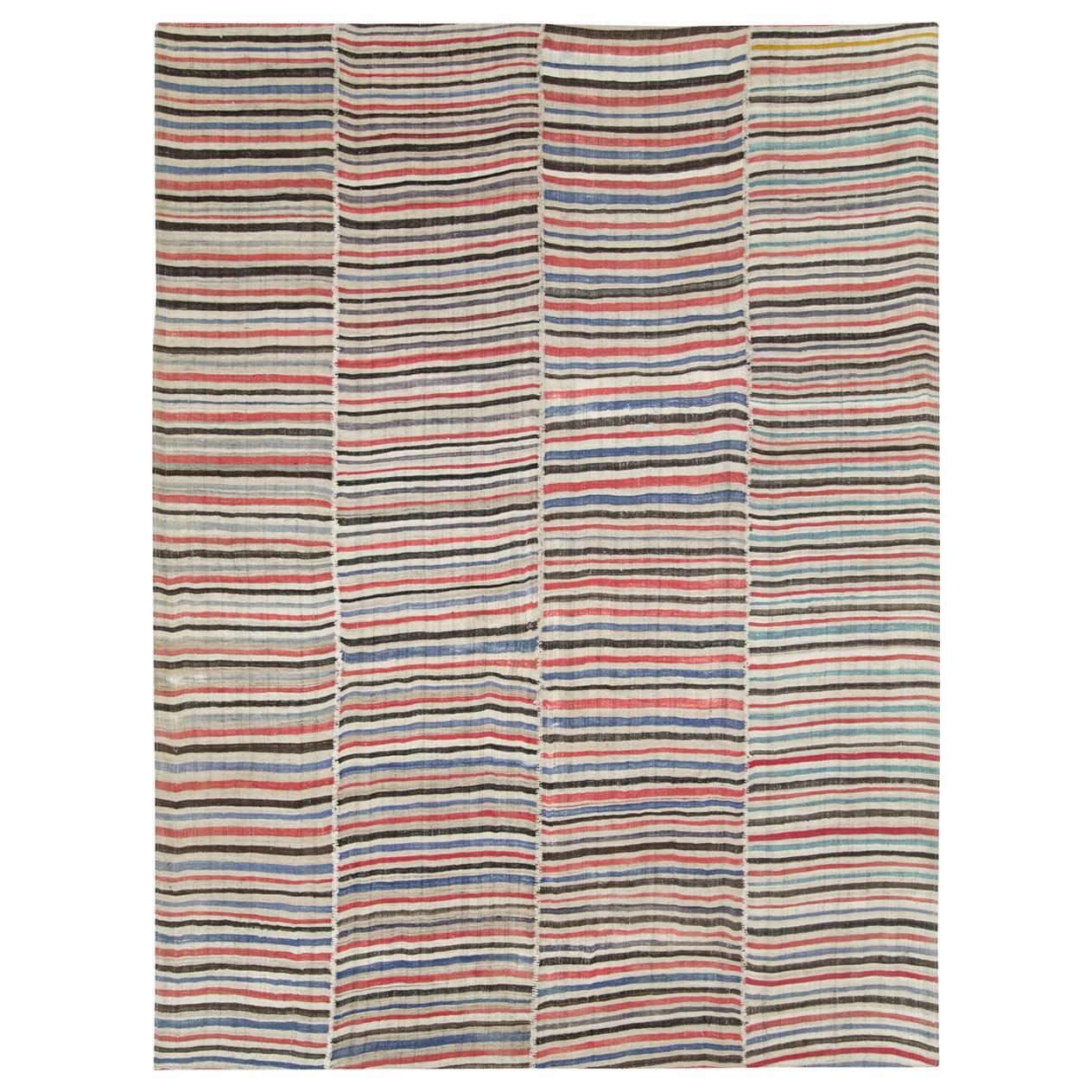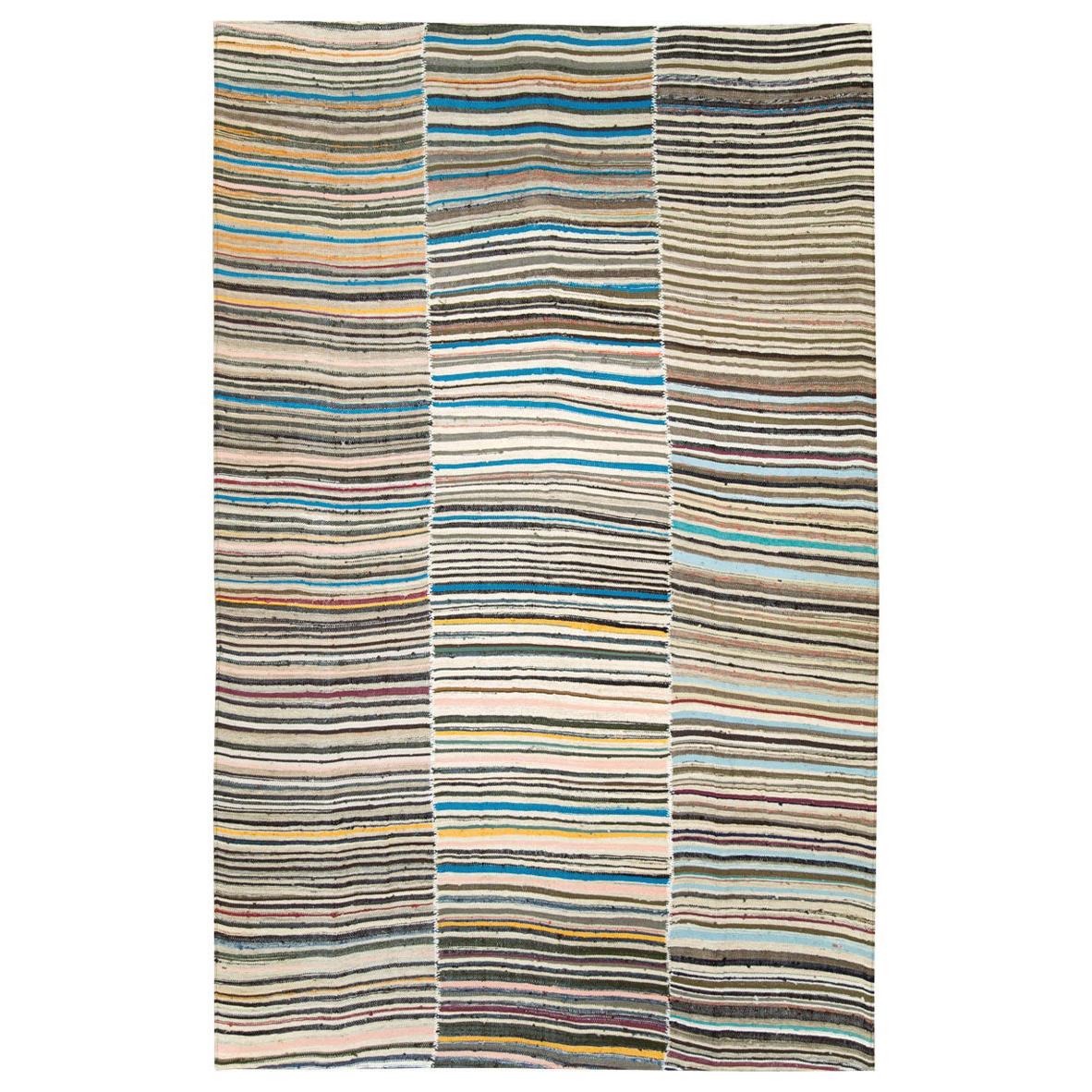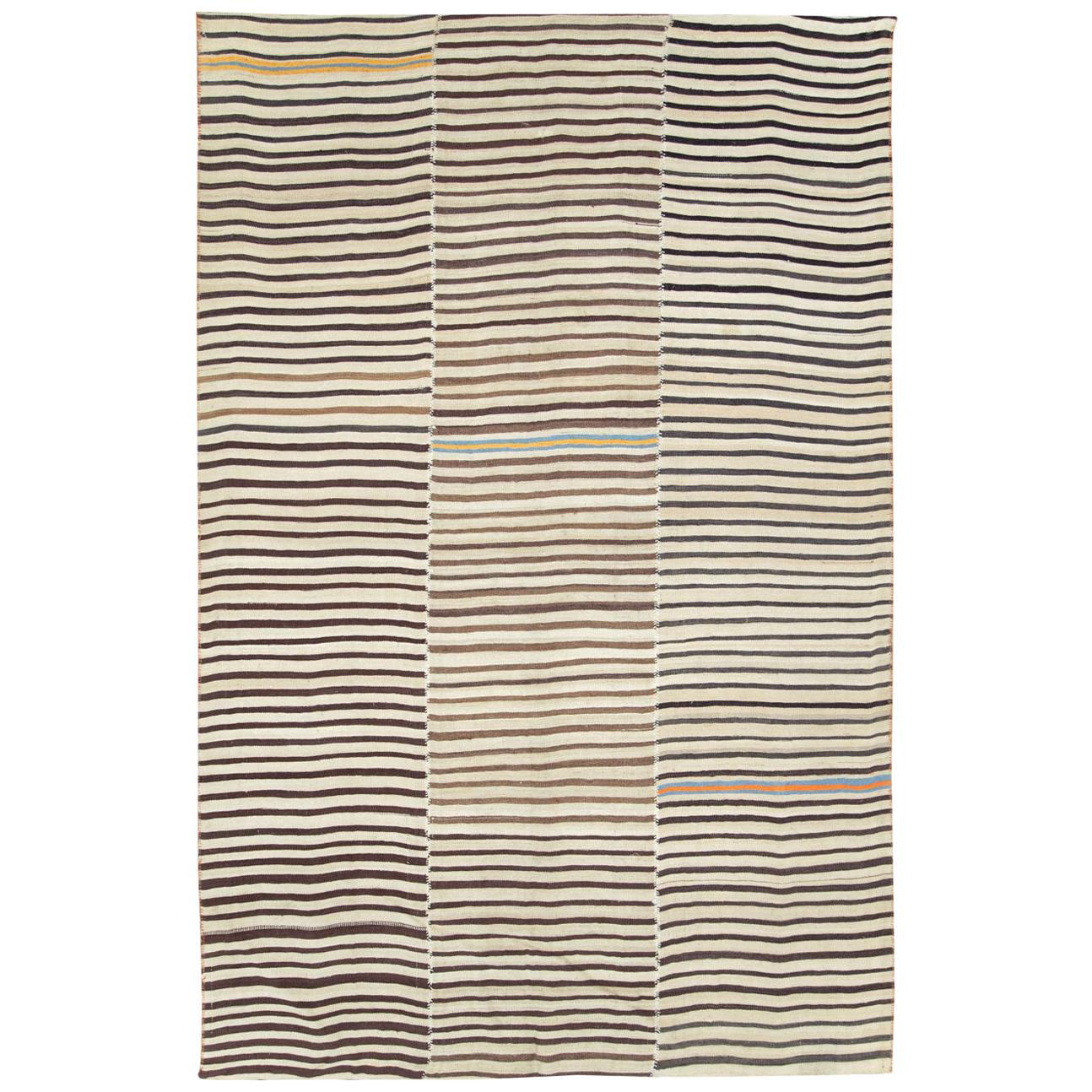Items Similar to Contemporary Handmade Persian Flat-Weave Kilim Accent Rug
Want more images or videos?
Request additional images or videos from the seller
1 of 10
Contemporary Handmade Persian Flat-Weave Kilim Accent Rug
About the Item
A modern Persian flat-weave Kilim accent rug handmade during the 21st century.
Measures: 3' 5" x 6' 8"
Flat-weave rugs & carpets:
Knotted pile rugs are just one small part of a vast universe of textile techniques suitable for heavy use. If you can imagine it, some weaver has tried it out. Pieces can be roughly divided into those reversible from the start and those never, or at least not initially, reversible. Thus, kilims are considered reversible, while everything else is not.
Kilims are tapestry woven rugs with both sides the same, in either slit technique where colors change, or with various methods of avoiding slits. Slit tapestry weave goes back to ancient times and Coptic Egyptian weavers used it for ornaments on garments and larger wall hangings. Slits can be avoided by dovetailing of colors (warp sharing) or by interlocking the wefts. The Navajo weavers of the Southwest practice the first while the fine shawl weavers of Kashmir and Kerman employed the second. Interlocking produces a one-faced fabric, with smooth and rough, ridged faces. The typical Turkish, Caucasian, or Persian rustic kilim shows slits, but never long ones. Aubusson French carpets are also slit tapestries and the long color transitions are sewn up as part of the regular maintenance. Some kilims are very fine. The best antique urban Sehna (Senna) kilims on wool, cotton or silk warps approximate the comparable rugs in refinement and are the most desirable of all Persian kilims. Although the various flatweave techniques are usually expressed in geometric, simple, often repeating, patterns, Sehna kilims demonstrate that even the most intricate designs can be effectively rendered in flat-stich. The term ‘kilim’ has been extended to cover any pileless, weft-faced heavy textile. Thus, the sectioned and joined northeastern Persian horizontally striped wool rugs are called ‘kilims’. So are the plain-weave end finishes of pile rugs. All these are weft-faced, weft patterned flatweaves.
These sectioned pieces are woven not on a frame loom, but one steadied by the weaver at one end and with the warps fastened down at the other. Only relatively recent have these tribal pieces become available. They are used as floorcoverings, hangings, room dividers, furniture covers. They are mostly bitonal in shades of natural dark brown and beige. Some more recent pieces show weaver innovations with ikat and moire effects. Work proceeds quickly and a skilled weaver can complete a thirty foot strip in almost no time.
Wefts, the elements added as weaving progresses, play an essential part in what is a flatweave. The best-known example of an extra-weft, wrapping technique is on Caucasian and tribal Persian Soumaks, where a pattern weft wraps around the fixed warp, changing as weaving progresses. Soumaks can be large carpets, Kuba in the Caucasus, small bag faces (Caucasian and Persian Shah Savan saddle bags), or cover scatter rugs (Persian Afshars). The Soumak technique is fast, and a weaver can work much more quickly than tying knots. The left-over wefts are cut off on the back, so the front and back are initially different. As a Soumak on the floor gets used, these weft yarns wear away and the two sides converge although the exact texture remains distinct.
There are other ways of pattern by weft. Often on smaller tribal pieces, the pattern weft(s) is (are) part of the weft structure, moving in an out, and holding the whole thing together. These wefts can be complementary or added (supplementary), continuous across the flatweave or cut off as they travel unneeded across the verso. Supplementary weft flatweaves are often very compact and substantial. The nomadic Turkmen and Balouch tribes employ both supplementary and complementary weft techniques on their pieces. Supplementary wefts are often raised on the recto (front) while complementary wefts are flat to the surface. Tribal Kurds employ this extra-wefting technique. The Balouch of Pakistan use complementary wefts almost exclusively on their small woven paraphernalia like salt bags.
Flatweave techniques may be combined on a single piece. Afshar rugs employ plain-weave end strips, preceded by Soumak bands, with pile sections between. The large Bakhtiari saddlebags feature Soumak work, pile “islands” an areas of plain-weave. Qashqai rugs and kilims frequently displays checkerboard end strips in continuous, complementary wefting.
Another distinct flatweave type is the jajim (jijim, cecim) in which a pattern is added with colored wefts as the weaving of the plain-weave ground progresses. Here the wefts are discontinuous and the pattern stands proud from the voided ground. Often made in two pieces on narrow looms and edge-sewn together, these may have geometric patterns. The term ‘jajim’ also refers to the assembled warp-faced strip and stripe covers from the Shah Savan of northwest Persia, the pattern is defined by warps alone, usually in plain stripes, but sometimes in designs of ladders, snakes, human figures and various animals. Here the color changing warps are continuous. Most are wool, a few are silk. Better to call these something else.
Indian ‘Dhurries’ are all cotton kilims and ‘shatrangis’ employ wool wefts on cotton warps. Dhurries are slitless. The cotton texture is more appropriate to the humid and warm climate of the Indian subcontinent. Modern Dhurries are horizontally striped or show repeating patterns of squares, but the very oldest are more curvilinear and even pictorial.
Sometimes the pattern is reversed, red for blue, blue for red. This double faced, usually heavy fabric is best in wool. Not a true double cloth, but a good tribal approximation. The wefts are continuous here
and the piece has double the life.
Flatweaves can also be created by embroidery. Pattern yarns are passed through a ground fabric with a needle or hook, not on a loom while in progress, but on finished sections of plain-weave affixed to a frame. The work can be divided among several artisans and the sections later joined. This technique was used in Britain and France, especially in large carpets with repeating squares patterns. Wool is the embroidery material of choice, the technique is needlepoint, and the ground is linen. Embroidery is used on very few Oriental rugs, but it does appear on the silk on linen or cotton Caucasian 17th-18th century pieces in floral, pictorial, or mihrab arch layouts. These are not really rugs and are not reversible.
There are combinations of flatweave techniques and knotted pile. The best known are the “soufs”, where a raise, relief pile stands above a brocaded ground. In the most luxurious examples, the ground is gilt silver or silver wrapped silk thread (metal thread) and the islands of pile are silk. This technique is found on certain Chinese rugs purporting by inscription to originate in the Forbidden City palaces and on certain Persian pieces including the early 17th century Isfahan “Polonaise” rugs.
Tapestry woven carpets with black grounds and rose bouquet repeating medallions come from Ukraine, southern Russia (Bessarabia), and Moldova. Large pieces are highly sought-after by designers.
If you can imagine a flatweave technique, a rug has probably been made with it.
- Dimensions:Width: 41 in (104.14 cm)Length: 80 in (203.2 cm)
- Style:Modern (In the Style Of)
- Materials and Techniques:Wool,Hand-Woven
- Place of Origin:
- Period:
- Date of Manufacture:21st Century
- Production Type:New & Custom(One of a Kind)
- Estimated Production Time:Available Now
- Condition:
- Seller Location:New York, NY
- Reference Number:
About the Seller
5.0
Platinum Seller
These expertly vetted sellers are 1stDibs' most experienced sellers and are rated highest by our customers.
Established in 1989
1stDibs seller since 2009
560 sales on 1stDibs
Typical response time: <1 hour
- ShippingRetrieving quote...Ships From: New York, NY
- Return PolicyA return for this item may be initiated within 3 days of delivery.
More From This SellerView All
- Mid-20th Century Handmade Persian Flat-Weave Kilim Accent RugLocated in New York, NYA vintage Persian flat-weave Kilim accent rug handmade during the mid-20th century. Measures: 5' 7" x 8' 7".Category
Mid-20th Century Persian Kilim Persian Rugs
MaterialsWool
- Mid-20th Century Handmade Colorful Persian Flat-Weave Kilim Accent RugLocated in New York, NYA vintage Persian tribal flat-weave Kilim accent rug handmade during the mid-20th century with 3 striped colorful columns incorporating cream, aubergine, and maroon, charcoal brown, ...Category
Mid-20th Century Persian Modern Persian Rugs
MaterialsWool
- Mid-20th Century Handmade Colorful Persian Flat-Weave Kilim Accent RugLocated in New York, NYA vintage Persian tribal flat-weave Kilim accent rug handmade during the mid-20th century with 4 striped colorful columns with white bindings. Measures: 6'7" x 8'9".Category
Mid-20th Century Persian Modern Persian Rugs
MaterialsWool
- Mid-20th Century Handmade Colorful Persian Flat-Weave Kilim Accent RugLocated in New York, NYA vintage Persian tribal flat-weave Kilim accent rug handmade during the mid-20th century with 3 striped colorful columns incorporating cream, brown, and blue, among other colors, an...Category
Mid-20th Century Persian Mid-Century Modern Persian Rugs
MaterialsWool
- Mid-20th Century Handmade Persian Flat-Weave Kilim Tribal Accent RugLocated in New York, NYA vintage Persian flat-weave Kilim tribal accent rug handmade during the mid-20th century currently in vogue with modern farmhouse interiors. Mea...Category
Mid-20th Century Persian Rustic Persian Rugs
MaterialsWool
- Contemporary Handmade Persian Flatweave Kilim Accent RugLocated in New York, NYA modern Persian flatwoven Kilim accent rug handmade during the 21st century. Measures: 5' 3" x 8' 1".Category
21st Century and Contemporary Persian Modern Persian Rugs
MaterialsWool
You May Also Like
- Persian Ziri Kilim Flat-Weave RugBy Mehraban RugsLocated in WEST HOLLYWOOD, CAA Persian Ziri Kilim flat-weave rug in purple, blue, and natural tones. The rug's texture and use of the color blocking technique brings dimension to any space and is both decorative...Category
Mid-20th Century Pakistani Kilim Persian Rugs
MaterialsWool
- Persian Edel Kilim Flat-Weave RugBy Mehraban RugsLocated in WEST HOLLYWOOD, CALive life in style with the Kilim flat-weave rug in dark brown and neutral colors. It is simple yet accommodating, making it an excellent rug for any design space. Rug number: 262...Category
21st Century and Contemporary Persian Persian Rugs
MaterialsWool
- Persian Edel Kilim Flat-Weave RugBy Mehraban RugsLocated in WEST HOLLYWOOD, CAThis richly deep and harmonious red Persian Edel Kilim flat-weave rug combines style and functionality. Use it for wall or floor applications, this piece can accentuate spacious inte...Category
21st Century and Contemporary Persian Kilim Persian Rugs
MaterialsWool
- Persian Kilim Flat-WeaveBy Mehraban RugsLocated in WEST HOLLYWOOD, CAA beautiful ivory and navy blue Persian Kilim flat weave. A simple yet interesting design with the blue stripes designed with a zipper-tooth effect. Persian flat weaves are made up o...Category
Mid-20th Century Persian Kilim Persian Rugs
MaterialsWool
- Antique Persian Jejim Kilim Flat-Weave RugBy Mehraban RugsLocated in WEST HOLLYWOOD, CAThis beige flat-weave rug has a simple, yet elegant, design that will look great in any design space. Thin brown stripes only add a touch to its simple and beautiful nature. Persian ...Category
Mid-20th Century Persian Kilim Persian Rugs
MaterialsWool
- Vintage Persian Jejim Kilim Flat-Weave RugBy Mehraban RugsLocated in WEST HOLLYWOOD, CAThe world of antique rugs and Kilims is one with a long and complex history, the fruits of which are the wonderful antique rugs and Kilims that have sur...Category
Mid-20th Century Persian Persian Rugs
MaterialsWool
Recently Viewed
View AllMore Ways To Browse
Designer Flats
Flat Bag
Small Square Bag
Large Woven Bag
Hand Bags Designer
Chinese Antique British Furniture
Designer Hand Bag
Oriental Accent Rugs
Black Saddle Bag
Travel Bag Red
Brown Saddle Bag
Blue Silk Oriental Rug
Weave Bag
Long Travel Bag
French Floor Rug
Long Front Bar
Very Large Chinese Rug
Small Flat Weave Kilim





